Since the world is not made of husbands and wives alone or for that matter boyfriends and girlfriends, the guide talks of including “partner” to everyday language to encompass the wide spectrum of what defines a “gender-inclusive lexicon”.Also the “gentleman’s agreement” is no longer fashionable and “honourable agreement” is cited as gender-inclusive.
Similarly the usage of man and woman must also create space for a “person.” Usage of “ancestors” in place of forefathers and “parenthood” instead of fatherhood and motherhood, substituting “housewife” with “homemaker” and “man-made” with “human-made” are some other suggestions. Similarly, a man in the street is an “average person” and trans sexual and transvestite may be substituted with transgender person and cross dressers.
The Supreme Court had earlier this year issued a handbook that contained a glossary of terms denoting gender stereotypes and suggested alternative words and phrases which may be used.
CJI Chandrachud calls for greater inclusivity and female representation in legal profession
Paving the way for institutionalising an inclusive lexicon in policy making by sensitising the administrative top brass and politicians and educational institutions to begin with, the “guide on gender inclusive communication” across homes, community and workspaces comes with a chapter with a glossary of over a 100 gender inclusive terms, adjectives, pronouns, honorifics, idioms and phrases that recast everyday expressions to subvert gender stereotypes. More words and expressions will be added going forward.
The guide prepared under the initiative of the WCD ministry has been compiled by the National Gender and Child Center, Lal Bahadur Shastri National Academy of Administration, Mussoorie, in collaboration with the Bill and Melinda Gates Foundation and UN Women.
Releasing the guide, minister for women and child development Smriti Irani said that an inclusive lexicon is crucial to achieving the vision of “women led development.” The minister said that going forward she was hopeful that LBSNAA will utilise the guide on inclusive communication to sensitise administrators from probationers to senior officials, so that the change begins to show in policy making down to the district level. The guide will also be shared with educational institutions and used to sensitise politicians.
“This guide is going to impact not only the lives of citizens and administrators, but ensure a future which is to be looked upon through the prism of gender justice,” Irani said. The minister said she hoped that the guide in the future will also be translated into other Indian languages.
Emphasising on gender neutral language in administration, the guide cites examples of gender non-inclusive language in policy drafting on subjects relating to men, women and every person. For instance, excerpts from the Mahatma Gandhi National Rural Employment Guarantee Act 2005 are cited to point out that the law only uses ‘he and his’ as a default term. Similarly the Maternity Benefit Act 1961 is focussed on women but the inspector in the Act is referred to as ‘he and his’.
In the glossary of words, for instance a “neutral zone” is an inclusive replacement for “no man’s land” and “middleman” is clearly not the right choice as “intermediary” is the suggested term. Next time you use “yes-man” think twice as the guide suggests “avid follower” instead.
Interpretation of some of the adjectives resulting in gender bias include ‘manly’, ‘old wives’ tale’, and ‘effeminate’. Instead the guide suggests use of ‘strong or mature’, ‘superstition’, and ‘delicate/soft or gentle’, respectively.
To demystify stereotypes the guide cites examples of non-inclusive usages like “Arjun and Lila both have full time jobs; he helps her with cooking. The inclusive usage suggested in the guide is: “Arjun and Lila have full time jobs; they cook together”.
Similarly, “a nurse knows that every day she will touch a life or a life will touch hers” is cited as non-inclusive. Instead it is suggested that one may say, “a nurse knows that everyday she/he/they will touch a life or a life will touch hers/his/theirs.”
The guide uses examples, illustrations and creates various scenarios by drawing from real life everyday conversations to highlight gender stereotypes and how this can be replaced with gender neutral and inclusive terms and expressions.






